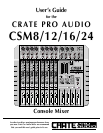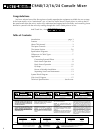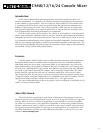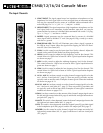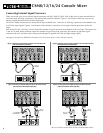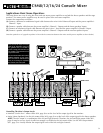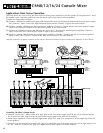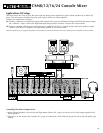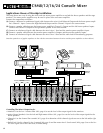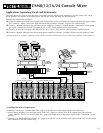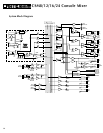
7
CSM8/12/16/24 Console Mixer
Equalization Diagrams:
Each input channel of the CSM8/12/16/24 has three bands of equalization which let you alter the tonal characteristics
of the input signal. The EQs may be used to add “color” or to compensate for inadequacies of the original signal. They also
may be used to cut frequencies to help eliminate unnatural sounds or to de-emphasize over-pronounced tones, and to help
prevent acoustic feedback. Each EQ has a range of 30dB (+/-15dB).
•The high EQ for each channel is a “shelving” type, with an action point (+6dB) at 6kHz, reaching maximum
effect at 10kHz and above.
•The middle EQ for each channel is a “peaking” type, which affects frequencies from 800Hz to 5kHz, centered
at 2kHz.
•The low EQ for each channel is a “shelving” type with an action point (+6dB) at 250Hz, reaching maximum
effect at 100Hz and below.
TIP = SIGNAL "+" (IN-PHASE)
RING = SIGNAL "-" (OUT-OF-PHASE)
SLEEVE = SHIELD
TIP RING
SLEEVE
RING
SLEEVE
BALANCED SIGNAL CABLE:
TIP
TIP = SIGNAL
SLEEVE = SHIELD
TIP
SLEEVE
SLEEVE
UNBALANCED SIGNAL CABLE:
TIP
PIN 2 = SIGNAL "+" (IN-PHASE)
PIN 3 = SIGNAL "-" (OUT-OF-PHASE)
PIN 1 = SHIELD
BALANCED MIC CABLE:
TIP = SIGNAL "+"
SLEEVE = SIGNAL "-"
TIP
SLEEVE
SLEEVE
*Speaker cables typically do not use or require a shield.
SPEAKER CABLE:
TIP
12
3
Differences in Cable Types:
This manual makes reference to different types of cables; in particular, balanced and unbalanced signal cables and
speaker cables. These are not the only types of cables associated with sound reinforcement, but they are similar enough to
each other to warrant a more descriptive explanation. For example, the three 1/4”-terminated cables below may look alike
at first, but upon closer examination their differences become apparent.
20
-10
0dB
+10
+20
-20
50 100 200 500 1k 2k 5k 10k 20kHz
Care must be taken to
avoid using SIGNAL cables
in place of SPEAKER cables
and vice-versa.
Signal cables aren’t made
to handle the power which
speaker cables do; speaker
cables are not shielded and
pick up external signals,
resulting in excessive hum
and buzzing.



